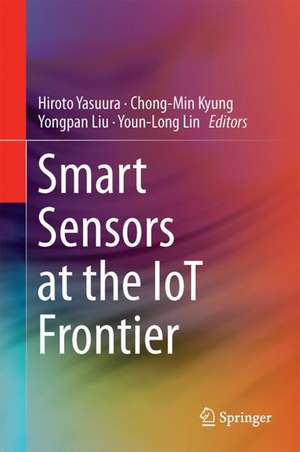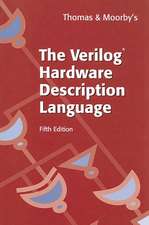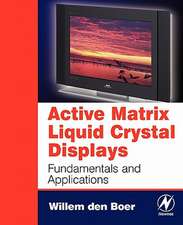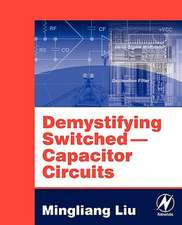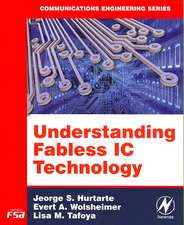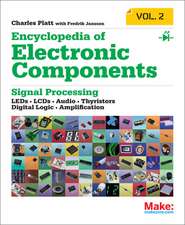Smart Sensors at the IoT Frontier
Editat de Hiroto Yasuura, Chong-Min Kyung, Yongpan Liu, Youn-Long Linen Limba Engleză Hardback – 8 iun 2017
| Toate formatele și edițiile | Preț | Express |
|---|---|---|
| Paperback (1) | 644.82 lei 6-8 săpt. | |
| Springer International Publishing – 2 aug 2018 | 644.82 lei 6-8 săpt. | |
| Hardback (1) | 900.49 lei 6-8 săpt. | |
| Springer International Publishing – 8 iun 2017 | 900.49 lei 6-8 săpt. |
Preț: 900.49 lei
Preț vechi: 1098.15 lei
-18% Nou
Puncte Express: 1351
Preț estimativ în valută:
172.33€ • 187.12$ • 144.76£
172.33€ • 187.12$ • 144.76£
Carte tipărită la comandă
Livrare economică 22 aprilie-06 mai
Preluare comenzi: 021 569.72.76
Specificații
ISBN-13: 9783319553443
ISBN-10: 3319553445
Pagini: 378
Ilustrații: VI, 378 p. 252 illus., 162 illus. in color.
Dimensiuni: 155 x 235 mm
Greutate: 0.72 kg
Ediția:1st ed. 2018
Editura: Springer International Publishing
Colecția Springer
Locul publicării:Cham, Switzerland
ISBN-10: 3319553445
Pagini: 378
Ilustrații: VI, 378 p. 252 illus., 162 illus. in color.
Dimensiuni: 155 x 235 mm
Greutate: 0.72 kg
Ediția:1st ed. 2018
Editura: Springer International Publishing
Colecția Springer
Locul publicării:Cham, Switzerland
Cuprins
Smart Sensors at the IoT Frontier - Introduction.- Part I: Device technology for IoT.- Chapter1. Energy-Autonomous Supply-Sensing Biosensor Platform Using CMOS Electronics and Biofuel Cells.- Chapter2. Smart Microfluidic Biochips.- Chapter3. Reducing Timing Discrepancy for Energy-Efficient On-Chip Memory Architectures at Low-Voltage Mode.- Chapter4. Redesigning Software and Systems for Non-volatile Processors on Self-powered Devices.- Part II: Sensing technology for IoT.- Chapter5. OEICs for High Speed Data Links and Tympanic Membrane Transducer of Hearing-Aid Device.- Chapter6. Depth estimation using single camera with dual apertures.- Chapter7. Scintillator-based Electronic Personal Dosimeter for Mobile Application.- Part III System and application.- Chapter8. LED Spectrophotometry and Its Performance Enhancement based on Pseudo BJT.- Chapter9. An air quality and event detection system with life logging for monitoring household environments.- Chapter10. Mobile Crowdsensing to Collect Road Conditions and Events.- Chapter11. Sensing and Visualization in Agriculture with Affordable Smart Devices.- Chapter12. Learning Analytics for e-Book-Based Educational Big Data in Higher Education.- Chapter13. Security and Privacy in IoT Era.
Notă biografică
Hiroto Yasuura is the Director of the System LSI Research Center and Professor in the Graduate School of Information Science, at Kyushu University, in Fukuoka, Japan.
Chong-Min Kyung received B.S. in EE from Seoul National University in 1975, M.S. and Ph.D. in EE from KAIST in 1977 and 1981, respectively. From 1981 to 1983, he worked at Bell Telephone Laboratories, Murray Hill. Since he joined KAIST in 1983, he has been working on CAD algorithms, 3-D graphics, and System-on-a-Chip design and verification methodology, development of various RISC/CISC microprocessors, VLIW and reconfigurable DSP cores. His current research includes system-level low-power design, electrical/thermal co-design in 3D IC, architectures of H.264 video CODEC and energy-rate-distortion-power optimization. He served as General Chair in the Korean Semiconductor Conference 2002, ISOCC 2004, A-SSCC 2007, and ASP_DAC 2008. He is founding Director of the IDEC(Integrated Circuit Design Education Center), andcurrently leads Center for Integrated Smart Sensors, funded as Global Frontier Project by Korean Government. He received the Most Excellent Design Award, and Special Feature Award in the University Design Contest in the ASP-DAC 1997 and 1998, respectively. He received the Best Paper Awards in the 36th DAC held in New Orleans, LA, the 10th ICSPAT, Orlando, FL, in September 1999, and the 1999 ICCD Austin, TX. In 2000, he received National Medal from Korean government for his contribution to research and education in IC design. He is a member of National Academy of Engineering Korea, and Korean Academy of Science and Technology. He is IEEE fellow and Hynix Chair Professor at KAIST.
Yongpan Liu received his B.S., M.S. and Ph.D. degrees from Electronic Engineering Department, Tsinghua University in 1999, 2002, and 2007. He worked as a Research Assistant in Circuit and System Divisions in Tsinghua University from 2002 to 2004. (Referred to CV) His mainresearch interests include: Embedded System, Nonvolatile Computing, Electronics Design Automation and Power/Thermal Aware VLSI Design and Test. Our group currently focuses on High Performance Low Power circuit device, chip architecture and system design methodology on next generation computing applications.
Youn-Long Lin is a Tsing Hua Chair Professor of Computer Science of the National Tsing Hua University. He was born in Yun-Lin, Taiwan. He received his B.S. degree in electronics engineering from National Taiwan University of Science and Technology (formerly, National Taiwan Institute of Technology), Taipei, Taiwan, in 1982, and his Ph.D. in computer science from the University of Illinois, Urbana-Champaign, IL, U.S.A. in 1987. Upon his graduation, he joined National Tsing Hua University, Hsin-Chu, Taiwan, where he established the THEDA Group (Tsing Hua EDA), served as Director of the University Computer and Communication Center, Chairman of the Department of Computer Science, Secretariat General of the University, Chief Librarian of the University Library, and the Dean of Research & Development. He is also an adjunct professor of Peking University, Beijing and a guest professor of Waseda University, Japan.
Chong-Min Kyung received B.S. in EE from Seoul National University in 1975, M.S. and Ph.D. in EE from KAIST in 1977 and 1981, respectively. From 1981 to 1983, he worked at Bell Telephone Laboratories, Murray Hill. Since he joined KAIST in 1983, he has been working on CAD algorithms, 3-D graphics, and System-on-a-Chip design and verification methodology, development of various RISC/CISC microprocessors, VLIW and reconfigurable DSP cores. His current research includes system-level low-power design, electrical/thermal co-design in 3D IC, architectures of H.264 video CODEC and energy-rate-distortion-power optimization. He served as General Chair in the Korean Semiconductor Conference 2002, ISOCC 2004, A-SSCC 2007, and ASP_DAC 2008. He is founding Director of the IDEC(Integrated Circuit Design Education Center), andcurrently leads Center for Integrated Smart Sensors, funded as Global Frontier Project by Korean Government. He received the Most Excellent Design Award, and Special Feature Award in the University Design Contest in the ASP-DAC 1997 and 1998, respectively. He received the Best Paper Awards in the 36th DAC held in New Orleans, LA, the 10th ICSPAT, Orlando, FL, in September 1999, and the 1999 ICCD Austin, TX. In 2000, he received National Medal from Korean government for his contribution to research and education in IC design. He is a member of National Academy of Engineering Korea, and Korean Academy of Science and Technology. He is IEEE fellow and Hynix Chair Professor at KAIST.
Yongpan Liu received his B.S., M.S. and Ph.D. degrees from Electronic Engineering Department, Tsinghua University in 1999, 2002, and 2007. He worked as a Research Assistant in Circuit and System Divisions in Tsinghua University from 2002 to 2004. (Referred to CV) His mainresearch interests include: Embedded System, Nonvolatile Computing, Electronics Design Automation and Power/Thermal Aware VLSI Design and Test. Our group currently focuses on High Performance Low Power circuit device, chip architecture and system design methodology on next generation computing applications.
Youn-Long Lin is a Tsing Hua Chair Professor of Computer Science of the National Tsing Hua University. He was born in Yun-Lin, Taiwan. He received his B.S. degree in electronics engineering from National Taiwan University of Science and Technology (formerly, National Taiwan Institute of Technology), Taipei, Taiwan, in 1982, and his Ph.D. in computer science from the University of Illinois, Urbana-Champaign, IL, U.S.A. in 1987. Upon his graduation, he joined National Tsing Hua University, Hsin-Chu, Taiwan, where he established the THEDA Group (Tsing Hua EDA), served as Director of the University Computer and Communication Center, Chairman of the Department of Computer Science, Secretariat General of the University, Chief Librarian of the University Library, and the Dean of Research & Development. He is also an adjunct professor of Peking University, Beijing and a guest professor of Waseda University, Japan.
Textul de pe ultima copertă
This book describes technology used for effective sensing of our physical world and intelligent processing techniques for sensed information, which are essential to the success of Internet of Things (IoT). The authors provide a multidisciplinary view of sensor technology from materials, process, circuits, to big data domains and they showcase smart sensor systems in real applications including smart home, transportation, medical, environmental, agricultural, etc. Unlike earlier books on sensors, this book provides a “global” view on smart sensors covering abstraction levels from device, circuit, systems, and algorithms.
- Profiles active research on smart sensors based on CMOS microelectronics;
- Describes applications of sensors and sensor systems in cyber physical systems, the social information infrastructure in our modern world;
- Includes coverage of a variety of related information technologies supporting the application ofsensors;
- Discusses the integration of computation, networking, actuation, databases, and various sensors, in order to embed smart sensor systems into actual social systems.
Caracteristici
Profiles active research on smart sensors based on CMOS microelectronics; Describes applications of sensors and sensor systems in cyber physical systems, the social information infrastructure in our modern world; Includes coverage of a variety of related information technologies supporting the application of sensors; Discusses the integration of computation, networking, actuation, databases, and various sensors, in order to embed smart sensor systems into actual social systems. Includes supplementary material: sn.pub/extras
